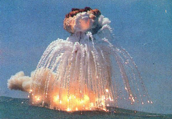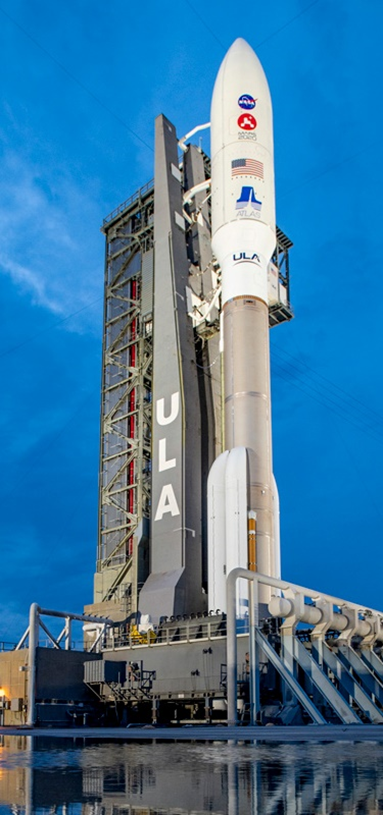
“Quantifying radiological risk for mission launch to key decision makers”
Sandia has supported space nuclear launch safety for both the Department of Energy (DOE) and the National Aeronautics and Space Administration (NASA) since 2006. Our support includes producing the final safety analysis report (FSAR) for the Mars Science Laboratory (MSL) mission launch in 2011 and the FSAR for the Mars 2020 mission launch in July 2020. NASA’s Mars Science Laboratory is a global pioneer in Martian landings, research, and exploration. The following webpages provide information, data, and charts to explain in detail the methodologies, scenarios, and approaches associated with Space Nuclear Launch Safety. The goal of safety analysis is to characterize a quantitative estimate of radiological risk and provide information on how nuclear safety can be improved. Sandia seeks to continue to deliver excellence and robust R&D in Launch Safety for all its customers and stakeholders.
Approach and Methodology
Sandia’s approach to Space Nuclear Launch Safety aids in the identification of main sources of risk. This allows for mitigating actions to reduce negative implication associated with mission failure. Additionally, Sandia implements risk estimation methodologies that include detailed simulations and Monte Carlo sequence codes to develop probabilistic risk analyses.
Accident Scenarios
Space Launch missions are divided into 6 phases. In each phase, an accident scenario is constructed to identify any potential risks. Breaking down the launch mission into 6 phases helps group accident environments into Representative Accident Scenarios (RASs). Sandia then combines the results from each RAS based on relative probability.

Projects
Sandia has demonstrated direct involvement with Space Nuclear Launch Safety through the generation of the Mars Science Laboratory (MSL) 2011 & Mars 2020 Final Safety Analysis Report. Research conducted by scientists at Sandia, government agencies and academic institutions culminated to a critical narrative describing the analyses and processes involved in making mission launch both safe and successful. Additionally, Sandia was involved in the Mars 2020 Nuclear Risk Assessment (NRA) for Mars 2020 Mission Environmental Impact Statement.
Current Projects
Sandia National Laboratories (SNL) is performing initial scoping analyses to quantify the risks of potential launch accident environments for other systems developed by other customers and comparing them against the safety guidelines in NSPM-20. This information can then be used to consider the safety implications of the designs and allow for modifications as needed to reduce the overall risk. Furthermore, SNL is working together with other customers to further the effort to ultimately obtain launch approval of upcoming potential missions.
Past Projects
Project Summary:
Sandia partnered with NASA’s Mars Science Laboratory (MSL) mission to generate a Final Safety Analysis Report (FSAR) for the 2011 Curiosity rover launch. Due to the radioactive material that was contained in the Multi-Mission Radioisotope Thermoelectric Generator (MMRTG), a safety analysis needed to be performed to model accidents and potential release of material into the environment. Launch approval was supported by the FSAR generated by Sandia and ultimately, launch approval was given. The MSL mission successfully launched from Cape Canaveral and landed on Mars. A link to a publicly available conference proceeding discussing the MSL source terms is provided below.
Principal Investigator:
Managers:
Project Summary
Sandia worked with NASA’s Mars 2020 mission to support the initial Environmental Impact Statement (EIS). NASA prepared an EIS in 2013-2014 in accordance with the National Environmental Policy Act – NEPA. Included in the EIS is information on the launch accidents risk to the general public and on-site workers at the launch complex. The Nuclear Risk Assessment documented the initial analyses of the Multi-Mission Radioisotope Thermoelectric Generator (MMRTG) during potential accident conditions for the Mars 2020 mission. The EIS was successfully issued and the Mars 2020 mission was able to proceed. A link to the publicly available Mars 2020 Nuclear Risk Assessment is provided below.
Principal Investigator:
Managers:
Project Summary
Sandia partnered with NASA’s Mars 2020 mission to generate a Final Safety Analysis Report (FSAR) for the 2020 Perseverance rover launch. This mission included the use of radioactive materials in a single Multi-Mission Radioisotope Thermoelectric Generator (MMRTG) to provide continuous power and heat for the mission. The radioactive nature of the fuel requires that safety and environmental protection be an inherent part of the design. The nuclear risks associated with the mission are described in an 1800-page mission FSAR, detailing the analyses and rigor involved in following standards that lead to safety and mission launch success. A link to the publicly available update to the Mars 2020 NRA based on the results from the Mars 2020 FSAR is provided below.
Principal Investigator:
Managers:
Why Sandia performs Space Nuclear Launch Safety
Due to the potential for release of radioactive material into the environment during a launch or earth-flyby accident, a safety analysis is required to assess the potential hazards from launch or return-from-orbit accident scenarios.
The goal of the safety analysis is to determine a quantitative estimate of radiological risk for use by decision makers. The risk analysis also provides information to mission designers on areas where nuclear safety could be improved, such as making modifications to the launch vehicle, space vehicle, or mission architecture. Such changes are best made early in the mission design to reduce budgetary or schedule impacts to the mission.




How Sandia is involved
Sandia researchers leveraged state of the art supercomputers to identify and quantify risks of the Multi-Mission Radioisotope Thermoelectric Generator (MMRTG) in the Perseverance rover launch. In the unlikely event of an accident, potential hazards from release of radioactive material from the MMRTG must be quantified and measured to ensure the safety of Earth’s environment and its people. Additionally, Sandia teamed with experts from other national labs, universities and government agencies to generate the Final Safety Analysis Report. The report explained the details and rigorous processes the team used when making critical analyses. With Sandia’s commitment to excellence, the Mars launch of the Perseverance rover was vetted for safety and success.



Depicted above are the MMRTG components, where it is placed on the rover, and how it is transported to Mars via the launch vehicle.
Sandia’s specific role in space launch safety analysis
Sandia performs the phenomenological modeling of the accident scenarios using an extensive launch safety code suite that includes:
- Blasts
- Impacts
- Fire
- Reentry
- Accident sequence options
- Atmospheric transport
- Consequences
Sandia quantifies the results into a probabilistic estimate of radiological risk and documents the analyses in a FSAR.
The FSAR provides the final results of the safety evaluation and is an essential document in the nuclear launch safety approval process. During preparation of the FSAR, Sandia interfaces with multiple agencies as needed. For example, for the Mars 2020 mission Sandia interfaced with DOE, NASA Jet Propulsion Laboratory (JPL), Interagency Nuclear Safety Review Panel (INSRP), Idaho National Laboratory (INL), and Los Alamos National Laboratory (LANL).
Contact
John Fulton
jdfulto@sandia.gov
Publications
Sandia publications related to this research can be found through OSTI.GOV.